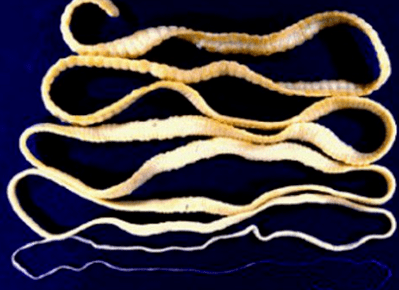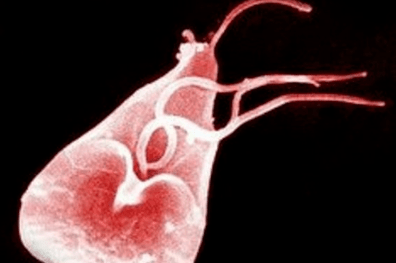Body parasitic infections are a frequent phenomenon that can be exposed to both children and adults (the first to a larger level, as they see worse hygiene).Internal parasites vary in places of localization in the carrier, features, structures, life cycles, and also affect carriers to a larger or lower level.Depending on the parasites that have appeared in the human body, the symptoms may also vary.

Type
Speaking of parasitic infections in the human organs, many patients think, first of all, about worms.However, there are many other types of invasion.In the human body, two types of parasites are the most common.They have different life cycles and delivery properties, as they need to be distinguished.
- The first type is worms that live in the human body, if not called helminths or worms.Hlybon invasion is concentrated primarily in the intestines, providing a clear and easy -to -be diagnosed symptom.Also, in general, it is easy to cure it, and usually does not harm adults and children.Such parasites come in two types - nematodes (round) and strip worms.It is transmitted through the fecal-oral path, that is, in order for the parasites in the human body to appear, it is necessary to swallow a large amount of their eggs, emitted with stools;
- Microscopic parasites in a person, ameba, and others are invisible to the eyes.The signs of parasites in the body in this case are more prominent.It is more difficult to cure them and it is difficult to diagnose, unlike the previous type.The effects of parasites on the human body are far more important, such infections can lead to the development and increase in chronic diseases and even life -threatening.The nature of transmission is fecal-oral, sometimes through blood and several other ways.
It is very important to know about the parasites that live in the human body, as this will help prevent infection.
Type
Parasites cause a variety of symptoms.Usually, it is localized in the organ or system they are impressed.Depending on the species, parasites in the body can lead important activities, eat and reproduce only in certain circumstances.Based on this, they are divided into species:
- Intestines (especially worms and flat worms - pinworms, ascarides, tape worms);
- Liver (especially microscopic protozoa - lamblia, etc.);
- Muscles (also, especially microscopic);
- Joints (just as in previous cases);
- Skin (micro-hot, fungus);
- Heart (mainly microscopic or damage by Helve larvae);
- Pulmonary (infection with worms with worms);
- Brain (form of worm larvae and simple organism);
- Parasites in human blood (microscopic protozoa);
- Genitals in the uterus, vagina (usually worms, but phenomena are relatively rare).

Each group listed causes certain parasite signs in the human body.Therefore, in order to diagnose the infection in a timely manner, you need to know what can cause it.
Localization
Although there are many places where parasites live in the human body, as can be seen from the parasitic group listed above, the most common is worms.These -cacing worms are localized, especially in the intestines.Depending on the species, they can live in the small or large intestine.There they breed, lay eggs and eat.That is, the active stage of their life cycle is underway.
These parasites in humans have a level of migration in which larvae fall into other organs (lungs, liver, brain, heart, muscles, etc.), attack them.This is due to the fact that from the intestines they fall into the local, and then into the same blood flow.So parasites in a person fall into all organs and systems.But there they form capsules around the larva and go to rest.However, they cause the development of inflammation, abscesses, sepsis.
Other people, for example, Giardia, live in the heart.There, the environment is best present for them, and therefore in their intestines and other systems they are in minimal quantities.The same way of life is BICIC.These parasites can attract the minimum part of their life cycle in the intestines, especially affecting other organs.
Some parasitic organisms live above the carrier's body.This is mainly a fungus or another.Depending on the species, they affect the skin, nails, scalp, mucous membranes.Micro-glow is another type of pest that lives on the skin and on the top.
General symptoms
Symptoms of the presence of parasites in the human body vary depending on the type of intrusion that strikes the body.But almost everyone is characterized by two signs - intoxication and allergic syndrome.
- Drunkenness develops due to body poisoning with parasitic products.It is caused by all types of parasites in the body.It is expressed as a continuous weakness of the carrier, pale, increased fatigue, chronic fatigue, drowsiness.In children, drunkenness can be expressed quite strong, in adults - as little as;
- The second common phenomenon that causes parasites in the human body is a symptom of allergies.This is due to the fact that the immune system, trying to protect the body from foreign agents, triggered the active production of histamine.If a lot of blood accumulates in the blood, then the allergy develops.Usually, these symptoms are mostly skin - rash, curf, but can also be breathing.
At the diagnosis of parasites in the body, we can conclude with the presence of certain immunoglobulin in blood tests.Regardless of the nature of the invasive agent, the immune system produces certain antibodies to combat it.If there is such an antibody, then there is an invasion in the body.And with the type of antibody you can understand which one.
Certain symptoms
How parasites affect the body depends on their type.Each has certain symptoms of infection with parasites.Forms of extracurricular infections with internal parasites (lambliosis, toxocarosis, opistorhoz, and others), as well as helminthic invasion with active infection of the internal organs at the stage of migration.The first signs with this flow are as follows:
- Increased body temperature, usually important;
- Chills;
- Sweating a lot;
- Sometimes there is an increase in lymph nodes;
- If the parasites hit the lungs, there will be little cough, which can be intensified over time and even enter the lungs;
- If the liver is defeated, then it increases, the pain is observed;
- When localized to the skin, rash and redness, peeling, itching appears;
- With intestinal worms, abdominal pain, bloating, bloating, nausea, weight loss, can cause constipation or diarrhea;
- With localization in the organs of the cardiovascular system, heart, arrhythmia, tachycardia, and other rhythm disorders are observed;
- The pain arising from the parasites in the muscles and the joints is not pronounced and appears periodically in the affected area.
It can be said that human parasites are present in the body, other symptoms can also be, but above are the most characteristic.The most characteristic evidence that the intestinal worm is in the body is the detection of individuals in the chair.
Treatment
Helminths or the easiest can live in someone long enough, without showing themselves.However, in the event of a suspicion of intrusion, you should immediately undergo diagnostic and make a diagnosis.Parasitologists or infectious diseases will tell how to treat the infection.
Helminth treatment is performed using anthelmintic drug.All certain drugs are divided into two groups.Preparation with a broad spectrum of actions killing parasites of several types and is set for invasion with unclear pathogens.Preparations with narrow spectrum are set when the invasion agent is installed, they are less toxic.
One should take such a drug.After 7-10 days, the second acceptance is prescribed as a protection against the possibility of self-abuse.Sometimes medications can be prescribed in short courses 3-5 days.The dose depends on the level of intrusion, the type of medication, the patient's weight and other factors.



























